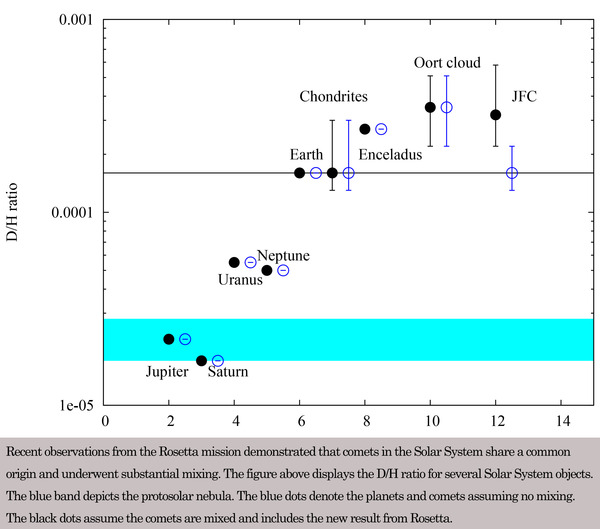Research Highlights
A clear confirmation from the Rosetta spacecraft that all comets share the same origin

In measuring the isotopic ratio between deuterium and hydrogen (called the D/H ratio) in water on the comet 67P/Churyumov-Gerasimenko, the Rosetta space craft has validated a fundamental prediction about the past evolution of the Solar System, called 'the Nice model'.
The Nice model describes how the Solar System evolved and obtained its current architecture since giant planet formation.
The fundamental characteristics of the model states that the orbits of the giant planets underwent a drastic instability that substantially changed their orbits 4.1 billion years ago.
A consequence of this instability is that the population of small bodies that were originally situated beyond Neptune were violently perturbed and dispsersed throughout the Solar System.
Some of these remain in the Kuiper Belt, situated just beyond Neptune, and the Oort cloud at thousands of Astronomical Units from the Sun (Brasser & Morbidelli, 2013).
At present the Kuiper Belt and the Oort cloud are the sources of the short-period and long-period comets respectively. In a recent study Brasser & Morbidelli (2013) predicted that, in the framework of the Nice model, the physical properties of these two populations of comets are statistically equivalent: they should both originate from the same reservoir of small bodies.
The comets may show variety from one to another but the populations of long-period and short-period comets should both show the same diversity, and roughly in the same proportion.
Their theory was confirmed twofold: Wang & Brasser (2014) demonstrated that the only source for the Halley-type comets is the Oort cloud and that the short-period comets have to originate from the Kuiper Belt (Brasser & Wang, 2014).
Up to now observations of comets appeared to have contradicted this theory. In essence, the D/H ratio of water vapour measured for three long-period comets (Halley, Hale-Bopp and Hyakutake) is rather high: about twice the value of Earth's water. In contrast, the first D/H ratio measured for a short-period comet (Hartley II) was comparable to the terrestrial value.
These results would imply a systematic difference between the D/H ratios of both populations of comets. Brasser & Morbidelli (2013) defended their predictions and warned of the traps of small number statistics: there are not enough observations to test their prediction thoroughly. Even so, they still held their breath.
Fortunately the Rosetta mission has put this issue to rest. The D/H ratio measured by the probe for the short-period comet 67P/Churyumov-Gerasimenko happens to be similar, and slightly higher than, that of the three long-period comets.
Adding that recent observations from the long-period comet 153P/Ikeya-Zhang, for which deuterium was not detected and thus implicating a D/H ratio far below that of other long-period comets, the results imply that there is no difference between comets that originate from the Kuiper Belt and Oort cloud, in accordance with the prediction of Brasser and Morbidelli (2013).
It appears the same diversity in the D/H ratios exists among both populations of comets. More observations are necessary to verify the exact proportions and if the highest ratios are the same for both populations.












